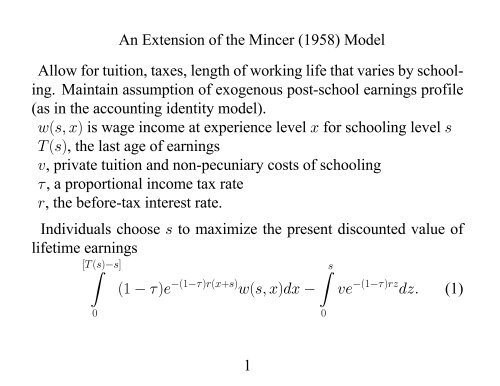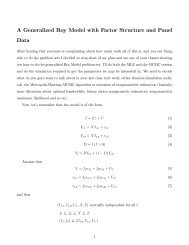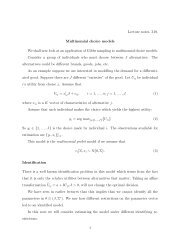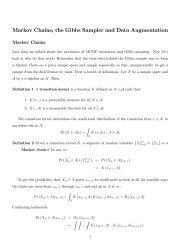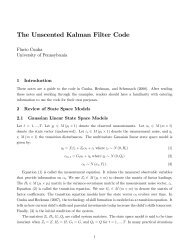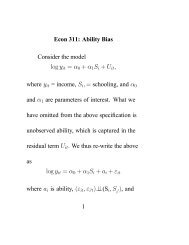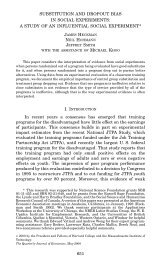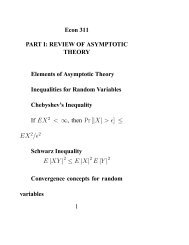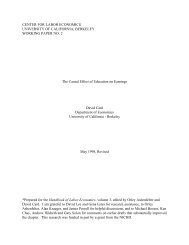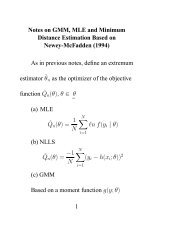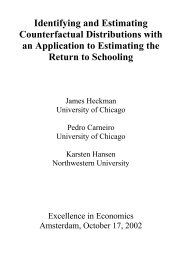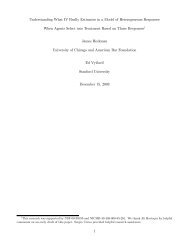Create successful ePaper yourself
Turn your PDF publications into a flip-book with our unique Google optimized e-Paper software.
An <strong>Extension</strong> <strong>of</strong> the <strong>Mincer</strong> (1958) <strong>Model</strong><br />
Allow for tuition, taxes, length <strong>of</strong> working life that varies by schooling.<br />
Maintain assumption <strong>of</strong> exogenous post-school earnings pr<strong>of</strong>ile<br />
(as in the accounting identity model).<br />
w(s, x) is wage income at experience level x for schooling level s<br />
T (s), the last age <strong>of</strong> earnings<br />
v, private tuition and non-pecuniary costs <strong>of</strong> schooling<br />
τ, a proportional income tax rate<br />
r, the before-tax interest rate.<br />
Individuals choose s to maximize the present discounted value <strong>of</strong><br />
lifetime earnings<br />
[T<br />
Z(s)−s]<br />
Z s<br />
(1 − τ)e −(1−τ)r(x+s) w(s, x)dx − ve −(1−τ)rz dz. (1)<br />
0<br />
0<br />
1
The first order condition for a maximum yields<br />
[T 0 (s) − 1]e −(1−τ)r(T (s)−s) w(s, T (s) − s) − (1 − τ)r<br />
T(s)−s<br />
Z<br />
· e −(1−τ)rx w(s, x)dx (2)<br />
+<br />
0<br />
T (s)−s<br />
Z<br />
0<br />
e<br />
−(1−τ)rx∂w(s, x)<br />
∂s<br />
dx − v/(1 − τ) =0.<br />
Defining ˜r =(1− τ)r (the after-tax interest rate) and re-arranging<br />
terms yields,<br />
[T 0 (s) − 1]e −˜r(T(s)−s) w(s, T (s) − s)<br />
T (s)−s<br />
R<br />
0<br />
e −˜rx w(s, x)dx<br />
(Term 1)<br />
2
+<br />
T (s)−s<br />
R<br />
0<br />
h i<br />
e −˜rx ∂logw(s,x)<br />
∂s<br />
w(s, x)dx<br />
T (s)−s<br />
R<br />
0<br />
e −˜rx w(s, x)dx<br />
(Term 2)<br />
−<br />
T(s)−s<br />
R<br />
0<br />
v/(1 − τ)<br />
e −˜rx w(s, x)dx<br />
(Term 3)<br />
=˜r. (3)<br />
• Term 1 represents a life-earnings effect – the change in the present<br />
value <strong>of</strong> earnings due to a change in working-life caused by additional<br />
schooling as a fraction <strong>of</strong> the present value <strong>of</strong> earnings measured<br />
at age s.<br />
• Term 2 is the weighted effect <strong>of</strong> schooling on log earnings by age<br />
• Term 3 is the cost <strong>of</strong> tuition expressed as a fraction <strong>of</strong> lifetime income<br />
measured at age s.<br />
• The special case in the <strong>Mincer</strong> model assumes v =0and T 0 (s) =1,<br />
3
which yields<br />
Z<br />
˜r<br />
T (s)−s<br />
0<br />
e −˜rx w(s, x)dx =<br />
Z<br />
T (s)−s<br />
0<br />
e<br />
−˜rx∂w(s, x)<br />
dx<br />
∂s<br />
• also assumes multiplicative separability between the schooling and<br />
experience components <strong>of</strong> earnings, so w(s, x) =µ(s)ϕ(x) (i.e. parallel<br />
in schooling). In this special case,<br />
˜r = µ0 (s)<br />
µ(s) . (4)<br />
If wage growth is log linear in schooling, so that µ(s) =exp(ρ s s)<br />
and the above assumptions hold, then the coefficient on schooling in<br />
a <strong>Mincer</strong> equation (ρ s ) estimates the rate <strong>of</strong> return to schooling, which<br />
should equal the after-tax interest rate.<br />
4


